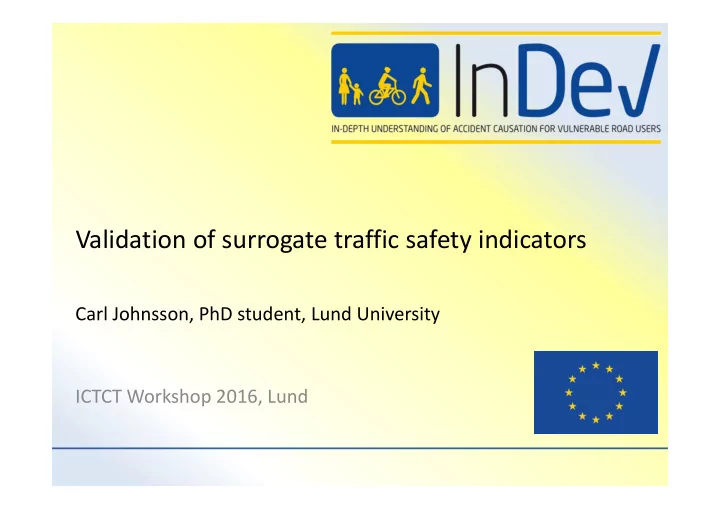

Validation of surrogate traffic safety indicators Carl Johnsson, PhD student, Lund University ICTCT Workshop 2016, Lund
Outline – Part 1 • What do we mean by validation? • Product validation – Previous product validation • Process validation – Previous process validation – Part 2 • Product validation in InDeV 27/10/2016 www.indev ‐ project.eu No. 2
What do we mean by validation? • Does an indicator actually “measure” the property you want to measure • Validity of an indicator means to what extent it describes (un)safety • Relation between accidents and conflicts 27/10/2016 www.indev ‐ project.eu No. 3
Product validation • Correlation between conflicts and accidents • Number of observed or expected conflicts • Number of recorded or expected accidents 27/10/2016 www.indev ‐ project.eu No. 4
Previous product validation • Linear correlation • Number of reported accidents • Number of observed conflicts ( TRRL, 1980 ) 27/10/2016 www.indev ‐ project.eu No. 5
Previous product validation • Hauer and Gårder (1986) • Variance of the Accident ‐ to ‐ conflict ratio, VAR( � ) ��������� ∗ � � ��������� • • “a technique (method, device) for the estimation of safety is “valid” if it produces unbiased estimates, the variance of which is deemed to be satisfactory.” 27/10/2016 www.indev ‐ project.eu No. 6
Previous product validation • Focusing on the variance of the Accident ‐ to ‐ conflict ratio ( Hydén, 1977 ) 27/10/2016 www.indev ‐ project.eu No. 7
Previous product validation • Linear correlation – Lord (1996) • Estimate the expected number of accidents using an accident prediction model • Number of observed conflicts 27/10/2016 www.indev ‐ project.eu No. 8
Previous product validation • El ‐ Basyouny & Sayed (2013) – Two ‐ phase model • Predict expected conflict rate using traffic volume, area type etc. • Predicted conflict rate used as input for negative binomial safety performance function 27/10/2016 www.indev ‐ project.eu No. 9
Previous product validation • Before ‐ after approach – Autey et al. (2012) • Before ‐ after conflict study – Sacchi et al. (2016) • Collision ‐ based full Bayes before–after safety evaluation ( Autey et al., 2012 ) 27/10/2016 www.indev ‐ project.eu No. 10
Process validation • Indicates the extent to which safety indicators can be used for describing the process that leads to accidents 27/10/2016 www.indev ‐ project.eu No. 11
Process validation • In ‐ depth accident studies or accident investigations by the police – Brake ‐ marks measured – interviews with involved road users and witnesses • Compare ”process” between accidents and conflicts 27/10/2016 www.indev ‐ project.eu No. 12
Previous process validation ( Hydén, 1987 ) ( Hydén, 1987 ) 27/10/2016 www.indev ‐ project.eu No. 13
Previous process validation • Video recorded accidents • Compare event leading to accidents compared to events leading to conflicts 27/10/2016 www.indev ‐ project.eu No. 14
Previous process validation ( Saunier et al., 2011 ) ( Saunier et al., 2011 ) 27/10/2016 www.indev ‐ project.eu No. 15
Part 2 Product validation in InDeV
Product validation in InDeV • 21 signalized intersections in 6 countries – Spain, Sweden, Denmark, Belgium, the Netherlands and Poland – 3 weeks of filming • Focus on pedestrians and bicyclists • Manoeuvre specific – Low number of recorded accidents 27/10/2016 www.indev ‐ project.eu No. 17
Product validation in InDeV – Similar approach to Lord (1996) • Expected number of accidents – Adapt safety performance function (SPF) – Nation and manoeuvre specific • Expected the number of conflicts – Based on observed conflicts • Focus on the variance of the Accident ‐ to ‐ conflict ratio 27/10/2016 www.indev ‐ project.eu No. 18
Product validation in InDeV • Comparison of two different methods to estimate safety. Expected number of conflicts Expected number of accidents 27/10/2016 www.indev ‐ project.eu No. 19
Visit us on www.indev ‐ project.eu Thank you very much for your attention! Carl Johnsson, PhD student, Lund University This project has received funding from the European Union’s Horizon 2020 research and innovation programme under grant agreement No 635895
Product validation in InDeV • Suggested accident model in InDeV �� ∗ ���� ��� �� – � ��������� � � ∗ ���� �� • �1 & �2 will be estimated based on literature 27/10/2016 www.indev ‐ project.eu No. 21
Satisfactory validation • Güttinger (1979) – The relation between serious conflicts and accidents must be stronger than the relation between traffic volume and accidents. – The relation between serious conflicts and accidents must be stronger than the relation between people’s opinion regarding road safety and accidents. 27/10/2016 www.indev ‐ project.eu No. 22
Recommend
More recommend